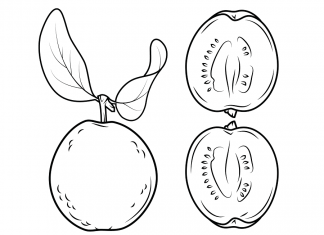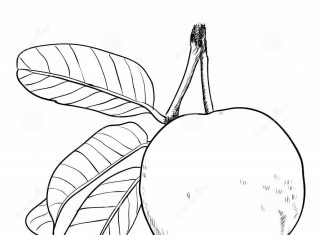Guava (Psidium guajava) is a tropical fruit that comes from the guava tree, which is a plant in the myrtle family (Myrtaceae). Guava is popular in countries with tropical and subtropical climates, where it is a valued source of food and is used in folk medicine.
Guava Coloring Pages
information
- Origins: Guava is probably native to Central and South America, but is now grown in many other tropical and subtropical regions around the world.
- Appearance: The guava fruit is round or oval, with fleshy flesh ranging in color from white to pink or orange. The peel can be green or yellow, and sometimes has fine bulges.
- Taste: Guava flesh has a distinctive sweet flavor with a hint of acidity, making it attractive to many people.
- A wealth of nutrients: Guava is a source of vitamin C, B vitamins, vitamin A, fiber and antioxidants. It is also low in calories.
- Culinary uses: Guava is eaten raw, often stripped of its seeds, which have a hard texture. It can also be used to make juices, jams, preserves, fruit mousses and an addition to salads and desserts.
- Medical value: In some folk medicine traditions, guava is considered a plant with health properties. Among other things, it is used as an anti-diarrheal, anti-inflammatory, antibacterial and digestive aid.
- Leaf utilization: In addition to the fruit, guava leaves are used in some regions as a medicinal herb. A tea or decoctions can be prepared from their leaves.
- Cultivation: Guava trees grow on guava trees, which are hardy and well adapted to the climatic conditions of the tropics. They are medium-sized trees with distinctive leaves and white flowers.
- Ecological Value: Guava trees are also ecologically valuable, as they can contribute to the reforestation of tropical areas, improving their ecosystem.
- Famous dishes: Guava is an ingredient in many local dishes in regions where it is widely available. In some countries, hot dishes are prepared from it, as well as desserts and snacks.
trivia
- Hawaii's most important fruit: Guava is considered one of the most important fruits in Hawaii. It is very popular there and grown on plantations.
- Applications in cosmetics: Extracts of guava fruit and its leaves are sometimes used in cosmetics because of their vitamin C and antioxidant content. They are used in skin care products.
- Presence in literature: Guava appears in many literary works, especially those set in tropical regions. It is described as a tasty fruit and is often used as part of descriptions of scenery.
- A memory in songs: In some cultures, guava is the subject of songs and musical pieces. Its taste and appearance can inspire artists.
- An ingredient in traditional beverages: In some countries, guava is used to prepare traditional drinks, such as "agua fresca" in Mexico or juices in tropical countries.
- Symbolism and cultural significance: In different cultures, guava can have different symbolic meanings. In some communities, it is a symbol of fertility, hospitality or health.
- First seedlings in the New World: Guava was one of the first fruits introduced to the New World by European settlers. Now it is a popular fruit in many Central and South American countries.
- Natural dye: Guava peel can be used as a natural food coloring to give dishes a pink or red color.
- Aroma and taste: Guava has a distinctive aroma that is often compared to a mix of pineapple, strawberry and melon scents. The taste is sweet with a hint of acidity.
- Traditional use of leaves: In some cultures, guava leaves have been used as natural packaging for food, much like banana or corn leaves.



